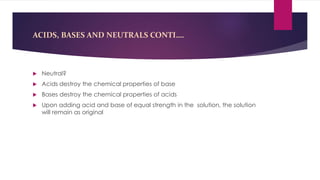Acids, bases & neutrals
- 1. Mr A. Mxadi ACIDS, BASES AND NEUTRALS
- 2. Lets Think for a momentâĶâĶ. Q: There is a clerk at the butcher shop, he is five feet ten inches tall, and he wears size 13 sneakers. What does he weigh? A: Meat. Q : Achmat have a loaf of bread, every time he eat it, he eat a half (1st half of loaf then half of the remained bread each time ). How long will it take him to finish the bread? A: 1). How would I know? 2). After 3 time 3).never finish 4). After 4 times
- 3. ACIDS, BASES AND NEUTRALS ïķ ACIDS, BASES AND NEUTRALS ïķ TASTE OF SUBSTANCES ïķ PROPERTIES OF ACIDS AND BASES
- 4. ACIDS, BASES AND NEUTRALS CONTIâĶ. Characteristic Acids Bases Molecular Level ïą An acid is a substance that, when dissolved in water increases the concentration of hydrogen ions in solution. ïą It is a proton donor ïą A base is a substance that, when dissolved in water, increases the concentration of hydroxide ions in solution ïą It is a proton acceptor Taste Sour Bitter Texture Sticky, give sharp stinging pain in a cut Slippery Physical Depending on the temperature, acids can occur in solid, liquid or gaseous form Mostly solids except ammonia which is a gas.
- 5. ACIDS, BASES AND NEUTRALS CONTIâĶ. ïĩ Neutral? ïĩ Acids destroy the chemical properties of base ïĩ Bases destroy the chemical properties of acids ïĩ Upon adding acid and base of equal strength in the solution, the solution will remain as original
- 6. ACIDS, BASES AND NEUTRALS CONTIâĶ.





